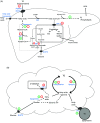Rare sugars: metabolic impacts and mechanisms of action: a scoping review
- PMID: 34505561
- PMCID: PMC9343225
- DOI: 10.1017/S0007114521003524
Rare sugars: metabolic impacts and mechanisms of action: a scoping review
Abstract
Food manufacturers are under increasing pressure to limit the amount of free sugars in their products. Many have reformulated products to replace sucrose, glucose and fructose with alternative sweeteners, but some of these have been associated with additional health concerns. Rare sugars are ‘monosaccharides and their derivatives that hardly exist in nature’, and there is increasing evidence that they could have health benefits. This review aimed to scope the existing literature in order to identify the most commonly researched rare sugars, to ascertain their proposed health benefits, mechanisms of action and potential uses and to highlight knowledge gaps. A process of iterative database searching identified fifty-five relevant articles. The reported effects of rare sugars were noted, along with details of the research methodologies conducted. Our results indicated that the most common rare sugars investigated are d-psicose and d-tagatose, with the potential health benefits divided into three topics: glycaemic control, body composition and CVD. All the rare sugars investigated have the potential to suppress postprandial elevation of blood glucose and improve glycaemic control in both human and animal models. Some animal studies have suggested that certain rare sugars may also improve lipid profiles, alter the gut microbiome and reduce pro-inflammatory cytokine expression. The present review demonstrates that rare sugars could play a role in reducing the development of obesity, type 2 diabetes and/or CVD. However, understanding of the mechanisms by which rare sugars may exert their effects is limited, and their effectiveness when used in reformulated products is unknown.
Keywords: Obesity; Rare sugar; Type 2 diabetes; d-psicose; d-tagatose.
Figures




References
-
- World Health Organisation (2015) Guideline: Sugars Intake for Adults and Children. Geneva: WHO. - PubMed
-
- Scientific Advisory Committee on Nutrition (2015) Carbohydrates and Health. Norwich: Public Health England.
-
- Mooradian AD, Smith M & Tokuda M (2017) The role of artificial and natural sweeteners in reducing the consumption of table sugar: a narrative review. Clin Nutr ESPEN 18, 1–8. - PubMed
-
- Izumori K (2005) Izumoring: a strategy for total production of rare sugars. J Biotechnol 118, S89–S90.
Publication types
LinkOut - more resources
Full Text Sources

